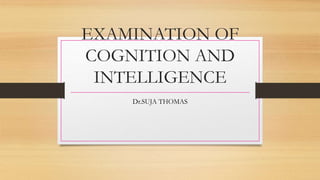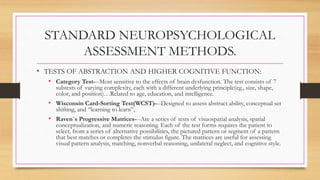This document provides an overview of cognition and intelligence, including definitions, related cognitive functions, types of intelligence, and methods of assessment and testing. It focuses on examining specific cognitive functions like attention, language, and memory. Tests are described to evaluate various aspects of cognition, such as digit repetition for attention, verbal fluency tests for language production, and confrontation naming for word retrieval. The levels of consciousness, anatomy of attention and language networks, and clinical implications of deficits are also summarized.











































![NEW LEARNING ABILITY
• When a patient cannot recall a given word, it is often possible to obtain an
indication of memory storage by the use of verbal cues.
• Semantic cues ( eg. “One word was a color”)
• Phonemic cues using syllabic components of the word ( eg., “Happ…..[happiness]”)
• Contextual cues ( eg., “a flower”)
-The demonstration of good memory on recognition testing but poor memory on free
recall is called IMPLICIT MEMORY.](https://image.slidesharecdn.com/intelligence-160728103517/85/Intelligence-44-320.jpg)



















































